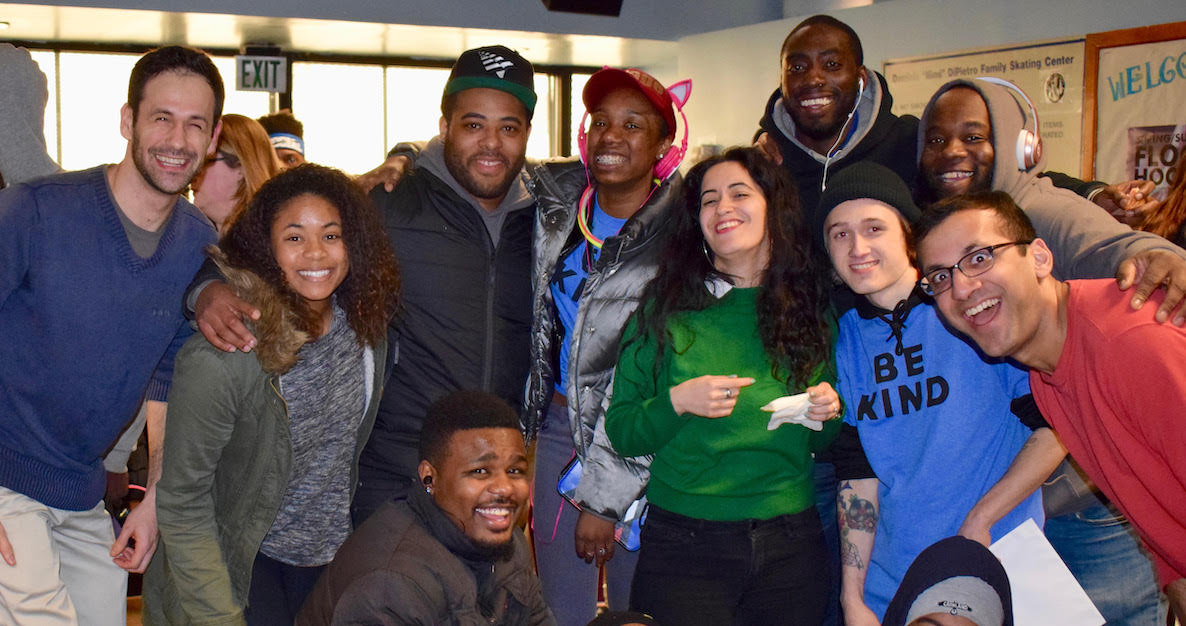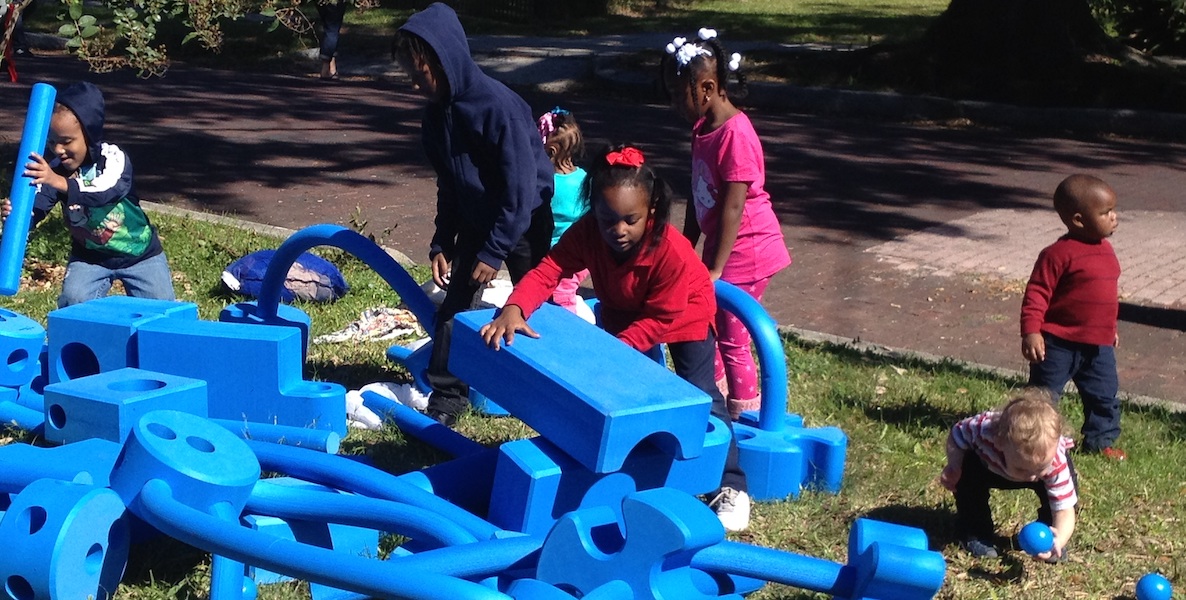For any Philly parent or child who’s visited the Please Touch Museum, the Imagination Playground is a familiar destination. A carpeted space adjacent to the carousel where children use oversized blue foam blocks and “noodles” to build whatever their brains dream up—life-sized igloos, basketball hoops, robots—it invites the kind of play that harkens back to a time before screens monopolized childhood.
But for children in New Orleans’ Central City neighborhood, where—13-plus years post-Katrina—swaths of homes remain decimated and 46 percent of people live in poverty, those building blocks represent more than play: They signify an opportunity to transcend race, class and history.
Angela Kyle, founder of the New Orleans nonprofit PlayBuild, was taken aback the first time she witnessed the transformative power of the materials. She was prototyping an early version of the PlayBuild concept and had the the Imagination Playground blocks set up at a farmers market for children to use, when she noticed a young African American boy, about 9 or 10, looking at her. She asked him if he wanted to play, and showed him pictures on her phone of another kids’ creations. “He looked at me with skepticism,” Kyle recalls. “‘Did a white kid do that?’ he asked.
The boy’s cynicism—the fact that his knee-jerk reaction was to assume something special couldn’t possibly be for him—could have broken Kyle’s heart. Instead, it strengthened her commitment to PlayBuild, which since 2012 has sought to transform blighted urban spaces in New Orleans into sources of design-focused play and community gathering.
“I wanted my daughter to grow up loving New Orleans and understanding the culture, architecture, food and our way of life—togetherness and family and neighbors. I really wanted her to feel that in a diverse way. And PlayBuild answered that call,” Dallman says.
“When this kid saw something that he perceived to be good and automatically associated it with something that he couldn’t do or achieve—that was the moment that solidified the importance of our mission,” says Kyle, who’d previously worked for New Orleans’ Business Alliance. “We have to give these kids confidence that their ideas and the way that they bring those ideas to life, and the way they express those ideas, is valid and that they deserve to be listened to.”
The mission of PlayBuild is to transform under-utilized urban spaces “to engage young people and empower them through design-related play: architecture, city-planning, sustainability.” The goal isn’t to turn out a generation of architects and engineers, Kyle says. It’s to restore a sense of pride and stewardship in the city’s young people—and the community around them—“to put them directly in touch with the transformation of the built environment so that they see the opportunity to be agents of that transformation and not just passive observers as whole blocks morph”—read: gentrify—“into something different.”
Unlike organizations focused on building traditional playgrounds, PlayBuild’s focus is on cultivating an awareness among children of the designed world around them—what makes it unique, the problems and potential that come with it. The materials available to the kids who come to PlayBuild reflect that: There are the Imagination Playground blocks, as well as tools like Magna-Tiles, Rigamajig (jumbo erector) sets, LEGO, and art supplies galore.
Learn more about PlayBuildDo Something
At PlayBuild’s one permanent space—which has a sheltered pavillion, permanent storage space, mini-kitchen for lunch and snack prep, and bathrooms—and at its two-dozen annual pop-up events at other locations around the city, children ages 4 to 12 learn about New Orleans landmarks and signature architecture, like the ubiquitous shotgun houses and their ties to traditions in Africa and the Caribbean. They learn about the impact of government-mandated highways that contributed to the decline of predominantly African American neighborhoods there and throughout the country. They learn about efforts to revitalize their city.
What academics have branded “design thinking” starts to come naturally to the kids, as exemplified when, while drawing an idealized version of his neighborhood, one 8-year-old PlayBuilder added a designated wheelchair lane for a neighbor he’d noticed going in and out of his home near PlayBuild’s primary site.
That site, a previously-neglected 30- by 90-foot parcel located between two housing projects where the average annual household income is below $20,000, is now a vibrant outdoor classroom full of possibility, where volunteers from within the community and from Tulane University run after-school programs, summer camps, and weekend activities. Other community groups—from artist collectives to Tulane professors—are invited to host community events too. PlayBuild also regularly operates pop-up programs, as when they set up play spaces along New Orleans’ signature “neutral ground,” the strip of land between opposite lanes of local traffic that for so long served as central gathering places for neighbors.
Debra Dallman is a New Orleans native who left the city for 25 years before returning five years ago with her husband and two kids. “When I came back, people warned me against living here. ‘Stay away from the whole Superdome downtown area,’ they said.” But when Dallman drove by PlayBuild’s site and saw how the community was working to restore it, she felt right at home. PlayBuild, she says, has played a critical role in her homecoming—and in her 9-year-old daughter’s upbringing.
“PlayBuild gives children the opportunity to experience and embrace the city that we New Orleaneans love and nearly lost [in Katrina]. I wanted my daughter Franki to grow up loving New Orleans and understanding the culture, architecture, food and our way of life—togetherness and family and neighbors. I really wanted her to feel that in a diverse way. And PlayBuild answered that call,” she says.
What academics have branded “design thinking” starts to come naturally to the kids. One 8-year-old added a designated wheelchair lane for a neighbor he’d noticed going in and out of his home near PlayBuild’s primary site.
Right now, PlayBuild operates on a shoestring $50,000 per year budget, one that Kyle would like to grow, in large part to help scale the operation to other cities. She also hopes to conduct some quantitative analyses of PlayBuild’s impact, ideally partnering with the schools PlayBuilders attend to assess various metrics in and out of the classroom. (Currently, PlayBuild measures its success anecdotally, in the kind of feedback they get from parents, volunteers, and community members—as well as in the demand for more events.)
What made PlayBuild take off in New Orleans, says Kyle, was largely the cheap cost of land—PlayBuild purchased their lot for less than $15,000—but also the proximity to so many schools and school-aged children, as well as the buy-in of local residents who recognized the dearth of green spaces, playgrounds, and kid-friendly outdoor areas in the community and longed for change.
Articles by Jessica PressRead More
Those are all key factors that, according to Owen Franklin, the Pennsylvania State Director of The Trust for Public Land, are critical to any public space improvement project. “When you have direct involvement from the community, you’re going to have a public space improvement that addresses the unique priorities and character of that community, you’re going to have people who are taking ownership of that investment, and you’re going to have people connecting to one another in new ways,” Franklin says.
Matt Rader, president of Pennsylvania Horticultural Society (PHS), concurs. Of the approximately 40,000 empty lots in Philly, PHS currently oversees and operates 12,000 parcels of land around (and with funding from) the city—land that they’ve cleaned, leveled, and on which they’ve planted turf and trees and in some cases installed fences—in the spirit of transforming vacant land from “being a source of anxiety, ugliness, and safety concerns” into something that “aids and supports quality community life.”
Rader says that PHS could be a good partner for a program like PlayBuild, but two things would have to be in place. First, the community and its leaders would have to want it. “Our belief is that any activation really should respond to community aspiration,” Rader explains. The second is making sure there’s funding in place—“not only to create the amenity, but to sustain it for a period of time.”
As in New Orleans, there are opportunities for real change in Philly. “There’s a lot of vacant land in Philadelphia, but the amount of it is declining each year with development. So there are two different kinds of thinking we need to be doing right now,” Rader explains. “One is asking what are the temporary changes we can make to vacant land to make it a community asset. The other is thinking about what of this vacant land we want to preserve in perpetuity, as parks and community gardens. And I think there’s important thinking that has to happen about what do we need to add to the basic building blocks of neighborhood infrastructure to make sure that this city is livable for the long-term?”
For that latter question, PlayBuild just may be the answer.







